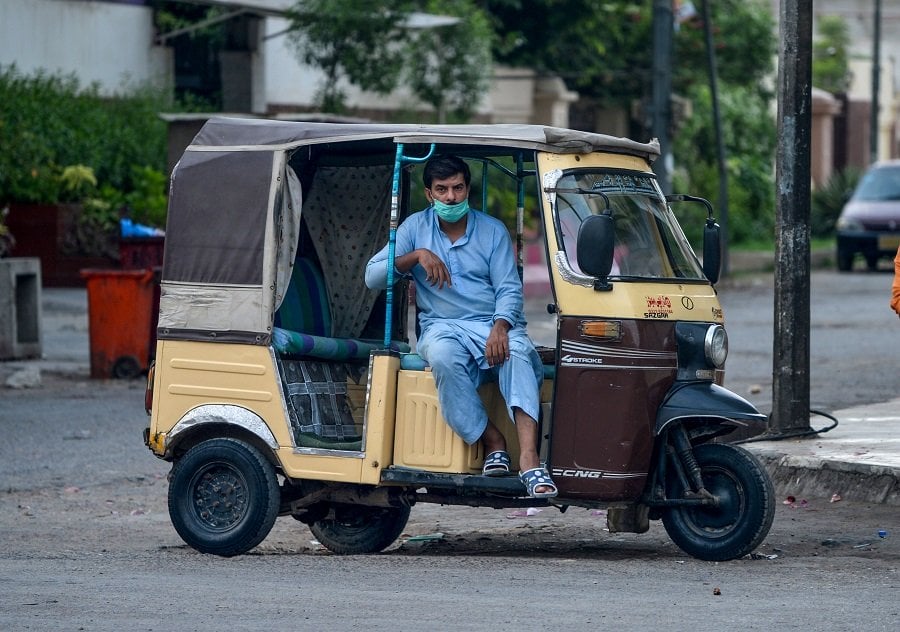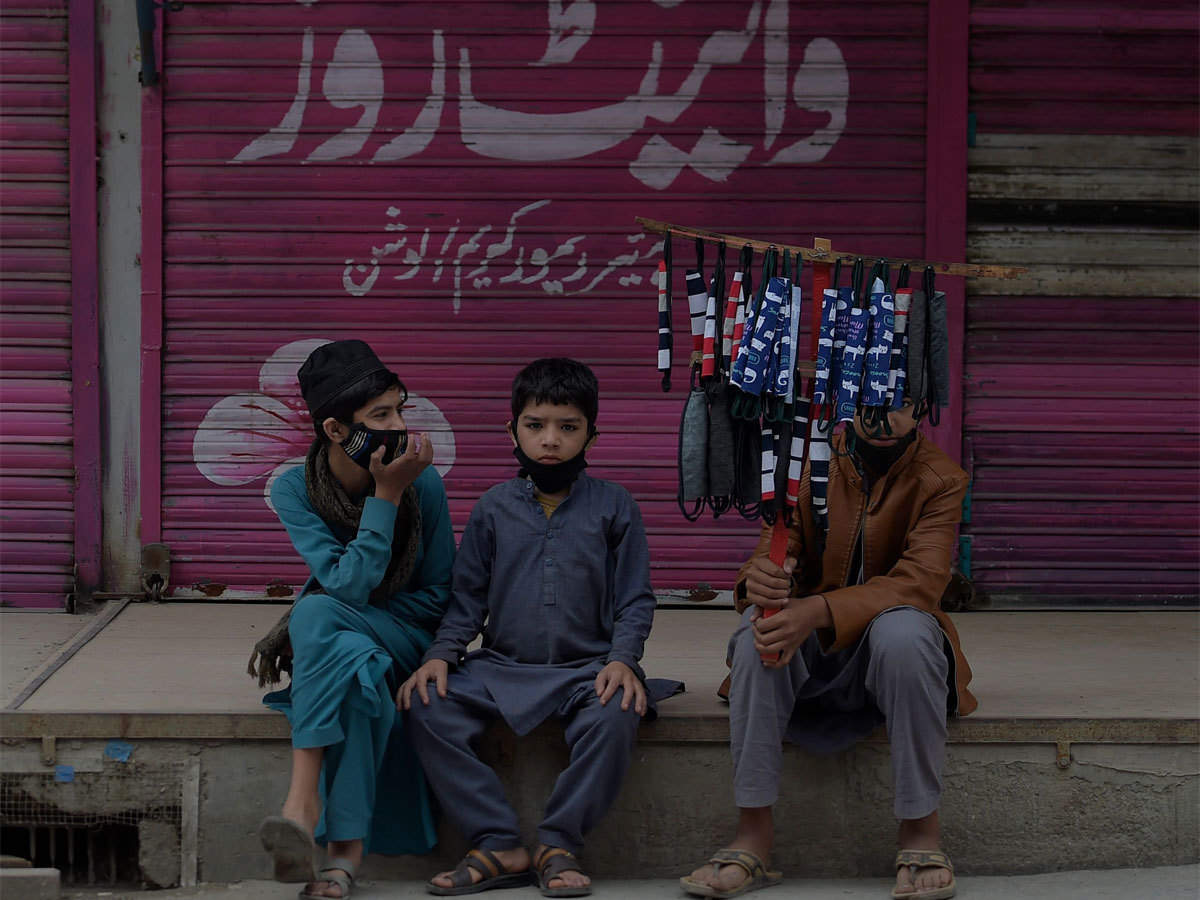The mystery of Pakistan's flattening Covid-19 curve
NCOC officials break down the country's coronavirus containment strategy, offering explanations for its seemingly miraculous recovery
A nation on the same page
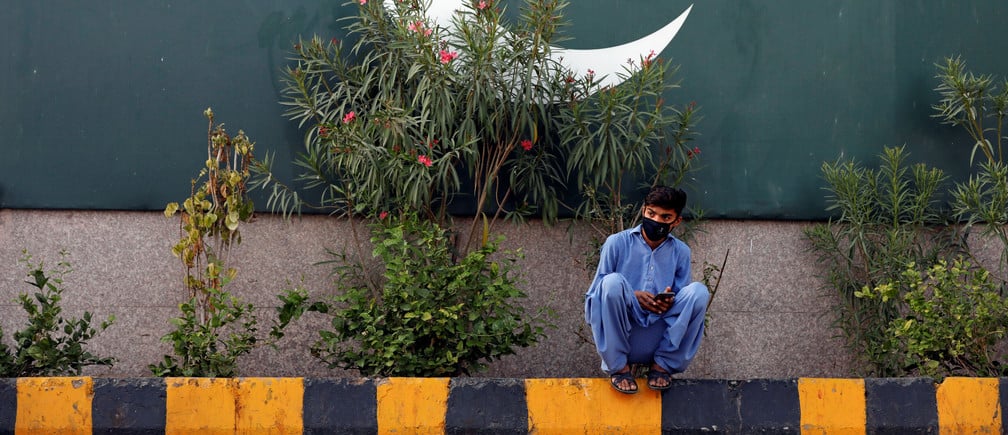
Speaking to The Express Tribune, officials from the National Command and Operation Centre (NCOC), the nerve centre of Pakistan’s Covid-19 containment efforts, offered some explanations as to why the country succeeded where others have not.
“Our strategy has been charactised by a ‘whole of the nation’ approach with unprecedented cooperation between the federating units,” one official explained. “Strategy-making has been centralised based on the national leadership’s intent and the maximum power has been delegated to NCOC by the National Coordination Committee,” he said.
“Because of this, we have been able to be flexible, adaptive and responsive in implementation at the operational level,” the official added. “All federating units have participate in this effort wholeheartedly and our consultative process with them has been dispassionate, open, two-way, evidence-based and data-driven.”
“The establishment of NCOC has also made decision-making much more efficient by ensuring any Covid-19 related decision in any department and ministry is taken under a single roof,” another official said. “Decisions once made are uniformly applied; any corrections suggested thereof are referred back to NCOC for consideration and recalibration of approach.”
“Due to its apolitical nature and participative, non-intrusive and all encompassing mode of operation, there is a high degree of trust in NCOC,” the official added. “This is why the Track, Trace and Quarantine (TTQ) and resource management strategies we devised were carried out with all out support from the federating units and the media.”
For a country like Pakistan, managing a global pandemic was never going to be an easy task. Where the developed world had the luxury to enact strict lockdowns from the get go, Pakistan due to poverty and lack of infrastructure found itself staring at a tightrope.
“We foresaw that the abruptly emerging Covid-19 crisis would be a protracted challenge for Pakistan,” an NCOC official said. “As the crisis emerged, we followed it up with reflexive national responses, but against the backdrop of widespread poverty and socioeconomic fragility, we realised these initial responses would not be scalable,” he told The Express Tribune.
Pakistan’s approach had to factor in both economic and social costs, the officials said. The International Labour Organisation (ILO) has estimated Covid-19 would wipe out as much 7.2 per cent manhours in the Asia-Pacific region alone, leaving up to 125 million workers without full-time work.
“In Pakistan, we estimated job losses could range from six to 16.5 million, many of which would be permanent,” the official said. “As many as 67 million people could potentially be pushed below poverty, increasing malnutrition and thereby reducing disease resistance.”
Concurrently with the pandemic, Pakistan faced the largest locust threat in 25 years, officials said. These harvest disruptions, coupled with supply chain issues, would have severely affected food stock availability across the country, particularly in less developed areas, they added.
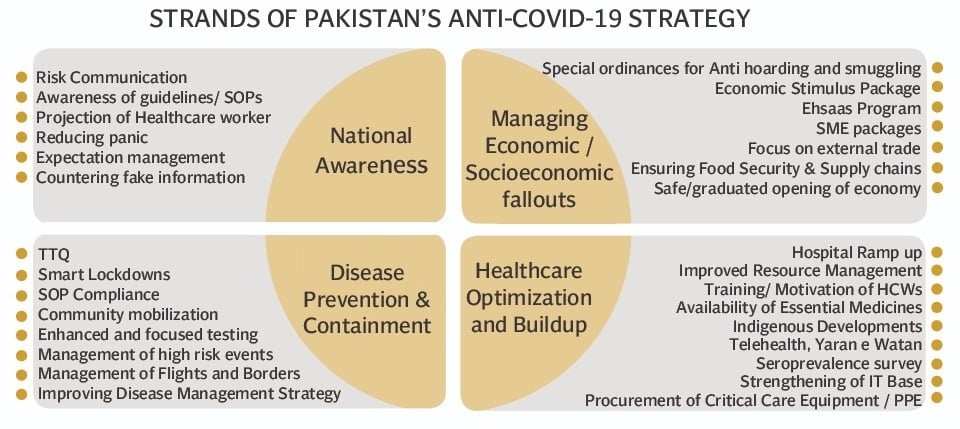
Speaking to The Express Tribune, officials said the NCOC’s Covid-19 strategy was devised along four strands: national awareness, disease prevention and containment, healthcare optimisation and buildup, and managing socioeconomic fallout.
“To increase national awareness of Covid-19, we carried out timely risk communication along with issuing guidelines and standard operating procedures to prevent the virus from spreading,” an official said. “We also undertook measures to reduce panic, manage expectations and prevent fake information from proliferating,” he added.
The second strand, disease containment, was broken down further into a ‘disease management improvement’, enhanced testing, TTQ, smart lockdown, SOP compliance and community mobilisation strategies, officials said. Side by side, the country also took measures to manage international travel and borders, along with high-risk events.
“Our daily testing capacity increased from 472 tests in February to over 60,000 tests, and the number of labs increased from four in the same month to 133,” the official revealed. “As many as 2.36 million tests have been conducted so far, and currently we are maintaining an average of 22,000 tests per day,” he said.
“Our lockdown strategy, meanwhile, has been adaptive and we move from general lockdowns to smart lockdowns and now, micro smart lockdowns, to zero down on the disease in the long term,” the official added. “At present, 62 micro lockdowns, which encompass small streets or a multi-storey building, have been imposed in 18 districts.”
Arguably the biggest challenge in terms of disease containment was managing high-risk events such as the easing of the lockdown, Eidul Fitr and Eidul Azha and Independence Day.
“We issued comprehensive guidelines for effective management of Eidul Azha to all federating after a deliberate consultation process,” the official said. “The NCOC monitored all pre-Eid activities for SOP compliance,” he added.
To optimise healthcare, the government embarked on a hospital ramp up, procuring critical care and protective equipment, improving resource management, and training and motivating healthcare workers, officials said.
“The federal government has so far added 2,690 oxygenated beds to the national health system,” the official said. “Domestic oxygen manufacturing was ramped up and we also took measures to ensure availability of essential medicines, while promoting indigenous developments that could help fight Covid-19,” he added. “The NCOC looked for ways to strengthen the IT base, and launched initiatives such as Telehealth and Yaran-e-Watan.”
On the socioeconomic front, the government took measures such as announcing a stimulus package and ramping up the Ehsaas programme, officials said. The government encouraged a gradual re-opening of the economy, and passed special anti-hoarding and anti-smuggling ordinances to ensure food and economic security.
The payoff
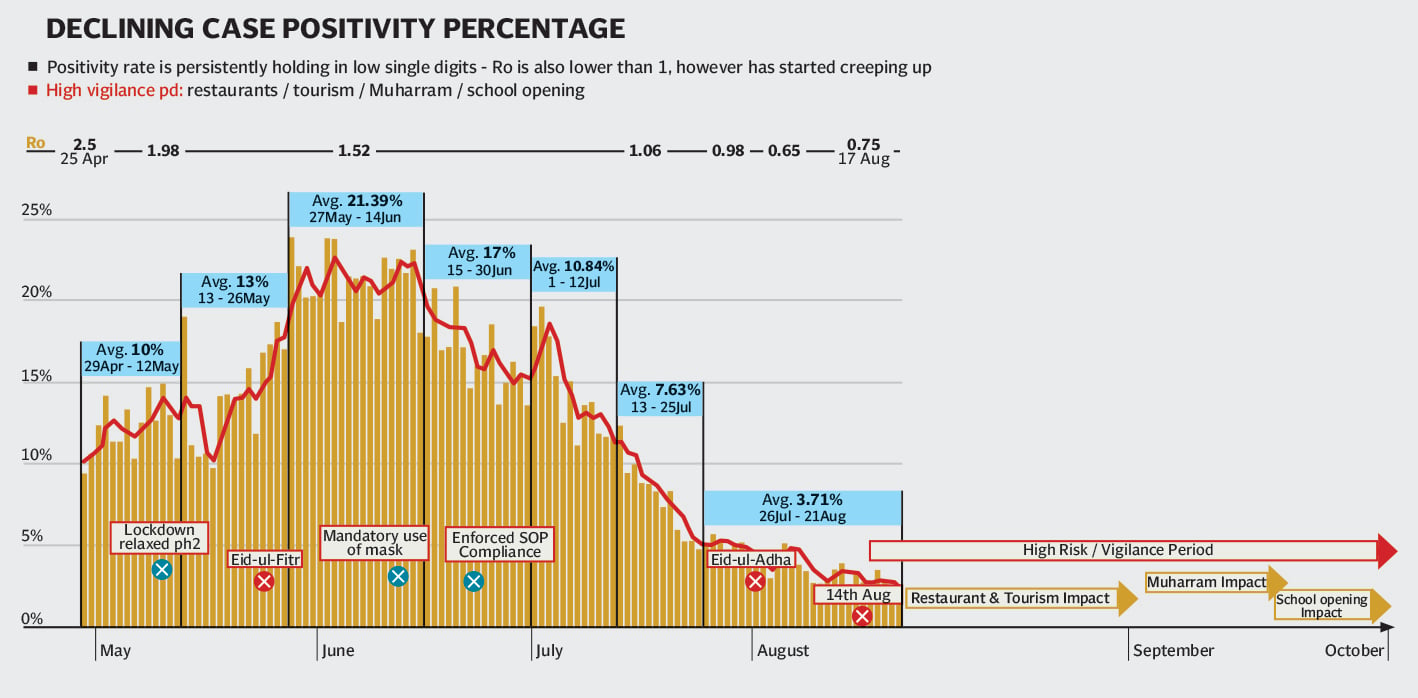
At present, all major indicators suggest a downward trend in Pakistan’s Covid-19 cases, officials said. “The Covid-19 test positivity rate is persistently holding in single digits,” said one official. “The basic reproduction number of the virus – R0 – is also lower than 1, although it has started creeping up again.”
They added that mortalities had also remained low after Eidul Azha, and average of 12 has been recorded over the last 20 days. “The reduced pressure on our healthcare is most evident from the fact that 89 per cent of our ventilators reserved for Covid-19 have been vacant,” the official said. “Due to efficient disease management and a synergised national effort, the number of cases has been declining consistently. Remarkably, Pakistan is highest percentage of recoveries in the region, at 93.8 per cent.”
Even more miraculously, Pakistan is the only country that managed to reverse a projected economic downturn, officials said. “The International Monetary Fund had projected in April this year that Pakistan would record GDP growth of -1.5. Two months later, the revised projection was much better at -0.4,” an official said. “This is all thanks to rational and timely policy decisions.”
That said, officials warned that any gains could prove temporary if the public and administration lower their guard anytime soon and neglect SOPs. “This is especially true in light of upcoming high risk events like Ashura and the opening of educational institutions,” an official said. “We are entering a high-vigilance period and resurgence of the disease cannot be ruled out in the winter.”
According to officials, a final decision on reopening educational institutes will be taken after a review on September 7. “It is possible that we may opt for a staggered opening, with either higher education institutes or schools opening first,” an official said.
Meanwhile, comprehensive SOPs for Muharram are in the process of implementation with the cooperation of religious clerics at province, district and tehsil levels, they added.
“Living with Covid-19 is a real possibility. It is as yet unclear when a vaccine will be available and immunisation is still likely to be challenge when it is,” warned an official. “There is no room for complacency. While we have tackled the disease effectively, the pandemic if far from over. Any celebrations will have to wait,” he said.
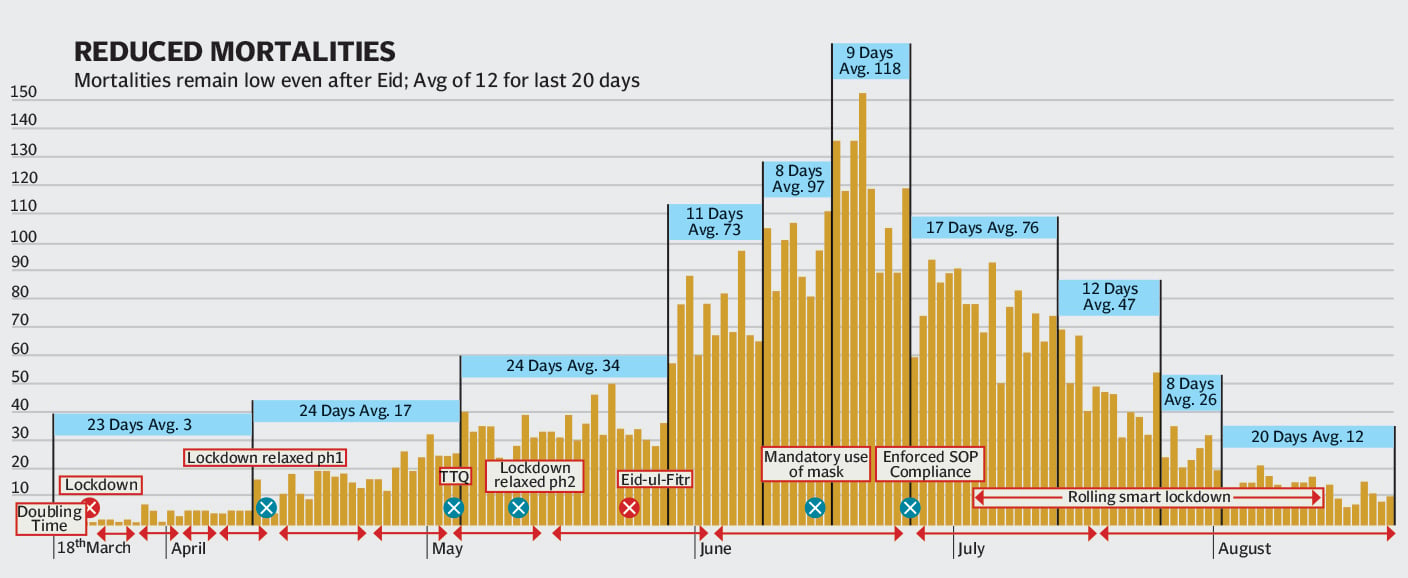
Story: Zeeshan Ahmad
Illustrations: Ibrahim Yahya
Photos: AFP, Reuters

